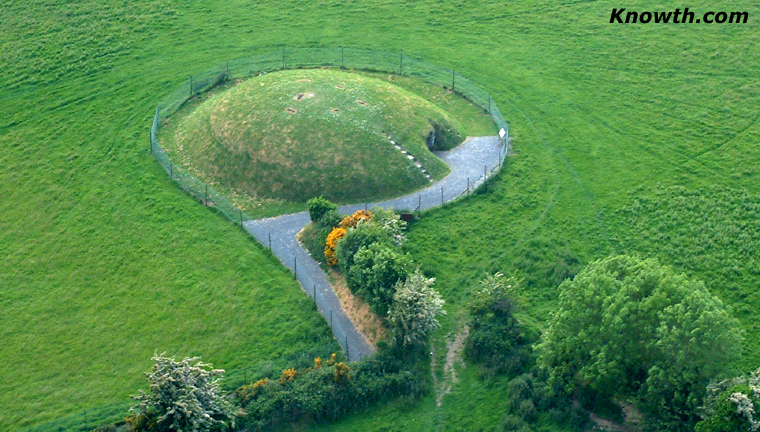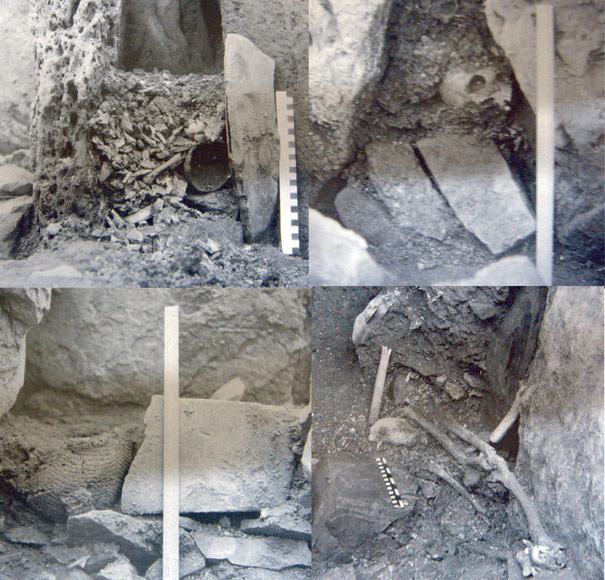
We Have Never Been Material.
Andrew Cochrane 2007 - Page 2SO HOW WERE THINGS? (Continued)
At one level, objects can influence the 'taken-for-granted' parts of an environment, helping to shape the habitus, in conscious and unconscious ways (Cooney 2000, 174; see also Droit 2005). Almost all of the objects discovered in passage tombs would fit well within an axis mundi worldview (see Cochrane 2005; Lewis Williams and Pearce 2005), with materials driving from the earth being utilised. The burning of certain parts (e.g. cremated bone) may have allowed elements to rise to the sky, while the interment within a passage tomb may have returned elements to the ground and completed a life biography. Such life cycles could include birth (production), socialisation (exchange), consumption, absence and death (discarded or destroyed) (Tilley 1996, 247; Cooney 2000, 175).The majority of human bone discovered in Irish passage tombs occurred in the form of cremated residue, with many persons generally being represented with successive burial acts often evident. That nonburnt human bones, such as skulls (complete and fragmented) at Fourknocks I, Newgrange Site 1 and the Mound of the Hostages, were incorporated might suggest modes of transformative action or illumination. The cremation of human bodies may not have been merely for functional perseveration and ease of transportation (Herity 1974, 122).

The mixing of substances - the fills of cremated and inhumed bones, skulls, and Carrowkeel pots from the cists and compartments in the Mound of the Hostages (O'Sullivan 2005, Figs. 65, 71, 74, 99).
At some level, the mixing of substances and parts in differing states may reflect the beliefs that human bodies are porous with elements, sensations and emotions continually flowing in and out in a cyclical fashion, both during life and after death (Grosz 1994, 165; Fowler 2004). For instance, in Melanesia some people regard themselves as 'dividual' persons that are 'partible' as a dominant aspect of personhood. These partible people often give 'parts' of themselves away as a means of maintaining or creating networks and relations with others (Gell 1999a, 33; Fowler 2004, 55). An interesting instance of how some people conceptualise themselves as partible beings is demonstrated by the Polynesians of the Marquesas, who have separate names for specific body parts in addition to their own name. Each named part would have its own life that related to other named members of the body and the community as a whole (Gell 1995, 44). In another example of how some people transmit essences between persons, Jones (2005) has commented on how some of the Classic Maya thought of themselves as permeable, consisting of blood and bone. By exchanging or giving these elements, relationships were manufactured, and strengthened (Jones 2005, 197) (see note).
In the context of Irish passage tombs, we may at some level be witnessing the residue of performances that sought to express beliefs on how some people were enmeshed within social relationships during life. By blending, circulating and depositing fragmented human body parts and remains after death, these worldviews may have been magnified. For some of the Araucanians of South America, the dismemberment and cutting up of the body (physical or otherwise) is linked to 'shamanic' initiatory practices of renewal, rebirth and regeneration (Eliade 1964, 53-4). The de-totalising of the body into fragments via cremation may have brought a new integrity to the dead as a whole, with placement in the passage tomb completing/commencing the transition. In such a scenario, cremation is cosmogony, with death being assimilated in the processes of regeneration or transformation (Parry 1982, 76), possibly through cyclical notions of time, from 'womb to tomb' (Parker Pearson 1999, 25). Such fluid practices would have been intimately linked with auditory, visual, olfactory, and tactile sensations, emotions and being-in-the-world in general.
The processes involved in these deliberate depositions may have been complex and diverse, with many factors determining combinations and arrangements of remains, probably being influenced by existing knowledge and beliefs on how things should be performed. Conversely, some of these interment acts may also have been ad hoc, sometimes renewing and at other times contesting the accepted relationships, statuses and biographies of objects and people. These deposits would have resonated with their own significances and this may have been enhanced by their capability to operate as mnemonic devices, practices of remembering and the distillations of knowledge about ever-changing worlds. Indeed, mortuary acts can function as mechanisms for the creation and perpetuation of a society (Bloch and Parry 1982, 6), often instigating feasts, mourning, celebrations and new conversations. The cremations would have occurred mostly outside the passage tombs themselves, possibly on funeral pyres or in burning trenches. Such actions could create numerous performances.
These may have included the preparation and purification of the body via hair removal, excoriation and washing, collecting the correct fuels to burn, the construction of a pyre or pit/trench (e.g. Fourknocks II), the placement of material goods (e.g. bone pins and pendants), burning and breaking up, washing of the cremated remains (as is evident from the chamber deposits at Fourknocks I and the Mound of the Hostages), transportation and lastly the deposition of the remains in containers, trenches, under stone slabs or in the passages, cists and chambers of megalithic tombs (also see discussions in Bloch 1982; Parry 1982; Gell 1995). Performances could also have more directly impacted upon some members of society. Parker Pearson (1999) has discussed how in the late nineteenth century amongst the Warramunga aborigines in Australia, some practised self-laceration, battering or self-immobilisation by cutting thigh muscles, while some New Guinea societies administered these acts on others. More harmful exploits can facilitate the death of a person or many through sacrificial killings. Less harmful actions can also include letting one's hair grow or cutting it, or participation in orgies of intoxication and sexual activity for extended periods of time (see Parker Pearson 1999, 1-3, 45-6). These performances would fit well within subversive carnivalesque environments and festivities.
Other undertakings may have included decisions on who should purify or make 'safe' the body and when. For instance with the Merina of Madagascar, some women often channel away the polluting elements of the body through mourning practices (Bloch 1982, 226). Choices may also have been made on who could attend, with certain people restricted. Within some rural Cantonese funerals young children, pregnant women and their husbands are very rarely permitted to attend funerals for fear of contamination (J. Watson 1982, 169). This may have been the case at times in the Irish Neolithic, or conversely the opposite might have been true. It is interesting to note the amounts of child remains that occur in passage tombs. If indeed the placement of the dead reflected regeneration practices, then children's remains may have assisted in facilitating these processes (Cooney 2000, 126); living children may also have been encouraged to attend funerary activities as a means of demonstrating expected ways of thinking, feeling and acting (DeBernardi 2002, 868). Indeed, it has been argued that in many societies children play a central role as social actors in determining how older people operate in not just funerary performances, but also in quotidian life (Harris forthcoming).
As a child socially matures its presence takes place in fluid and changing networks of persons that are not one-directional (Poole 2002, 839). Some people for instance of the Mount Hagen region of Papua New Guinea use the word mbo for the activity of planting, which can refer to the placement of cuttings into the ground and also any point of growth. As such, children are seen as mbo, and constantly come into being in the world through processes of taking root, growth and maturity that reverberate through the society as a whole (Ingold 2000, 83). If children were regarded in some sense as centrally operating within fields of human relations, then the occurrence and planting of unburnt and cremated children bones in the passages of the Mound of the Hostages and Fourknocks I and II, may reflect these possible beliefs. We should, however, not automatically assume that the child remains in anyway represented children or notions of 'childhood'. The placements may have been ambiguous, forming parts of performances that sought to magnify processes of maturation, closure, presence/absence, regeneration and juxtaposition. Conversely, the mixing of substances of differing ages and sexes, as is found at Fourknocks I and the Mound of the Hostages, may have reflected the pluralities of gender, identity and personhood that were thought to have existed through (in)dividual, partible and permeable mechanisms of social interaction (Gell 1999a, 35; Fowler 2004, 37). It is possible that both positions operated at the same time with cremation practices never being consistent and homogenous. Ultimately, the reshaping of deceased people via cremation and depositional processes may have created interconnected relationships that punctuated how living people saw and expressed themselves, the dead and the cosmos within the Irish Neolithic.
Note: The notion of a world filled with mixed, fluid and blended entities also permeates some Western perspectives - for example in 'cyberpunk' literature (see Gibson 1984), and in cinema, such as Blade Runner, Robocop and Videodrome. <Back>
Next Page (3)
Previous Page (1)
Boyne Valley Private Day Tour
 Immerse yourself in the rich heritage and culture of the Boyne Valley with our full-day private tours.
Visit Newgrange World Heritage site, explore the Hill of Slane, where Saint Patrick famously lit the Paschal fire.
Discover the Hill of Tara, the ancient seat of power for the High Kings of Ireland.
Book Now
Immerse yourself in the rich heritage and culture of the Boyne Valley with our full-day private tours.
Visit Newgrange World Heritage site, explore the Hill of Slane, where Saint Patrick famously lit the Paschal fire.
Discover the Hill of Tara, the ancient seat of power for the High Kings of Ireland.
Book Now
Home
| Newgrange
| Knowth
| Dowth
| Hill of Tara
| Fourknocks
| Loughcrew
| More Places
| Labyrinths
| Local Info
| Art Works
| Articles
| Images
| Books
| Links
| Boyne Valley Tours
| Contact
